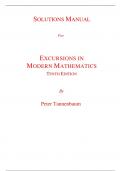Exam (elaborations)
Solutions Manual For Excursions in Modern Mathematics 10th Edition By Peter Tannenbaum (All Chapters, 100% Original Verified, A+ Grade)
- Course
- Institution
This Is The Original 10th Edition Of The Solution Manual From The Original Author All Other Files In The Market Are Fake/Old Editions. Other Sellers Have Changed The Old Edition Number To The New But The Solution Manual Is An Old Edition. Solutions Manual For Excursions in Modern Mathematics 10...
[Show more]



